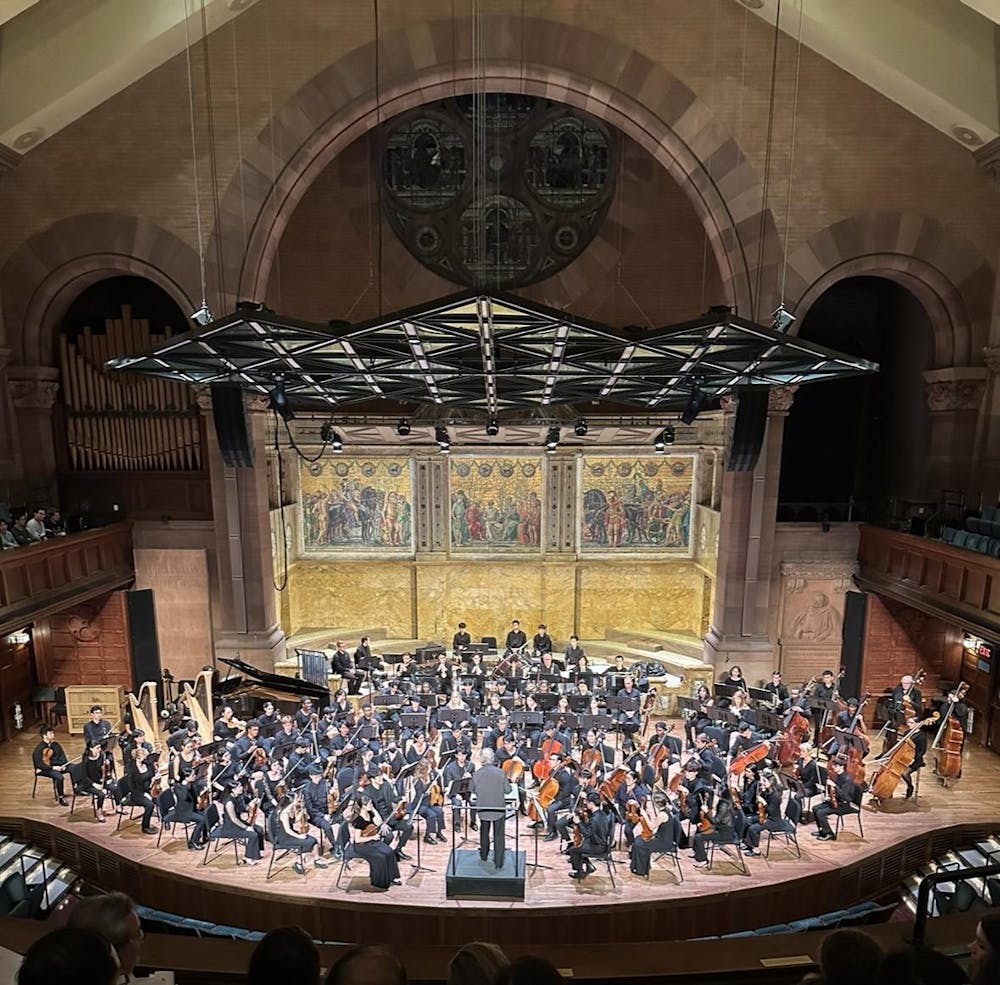Cello soloist Aster Zhang ’24 was playing the last — and most frenetic — movement of Shostakovich’s Cello Concerto No. 1 when the unimaginable happened: a string snapped. The music halted, and conductor Michael Pratt relayed a quick cue. Principal cellist Brandon Cheng ’25 swapped instruments with Zhang and proceeded off-stage. The movement picked up again, and Zhang and the orchestra concluded the concerto beautifully.
The Princeton University Orchestra (PUO) graced the Richard Auditorium’s stage on Oct. 6–7 for their fall concert. Students, professors, community members, and music lovers alike gathered to hear orchestral music played by the Univerisity's talented performers. The 2023–2024 season marks conductor Michael Pratt’s 46th year with PUO, a relationship that has named Princeton as one of the finest university orchestras. Pratt is also widely renowned through his work in the Music Minor in Performance program.
While the tensions on opening night were heightened by the altercation, fortunately, no more strings were snapped throughout the weekend. It is important to recognize how adaptive the orchestra was in this situation, displaying their professionalism, preparedness, and persistence.
During Saturday night’s performance, the audience sat in hushed anticipation as the performers’ instruments swelled, filling the auditorium with sound. The program was divided into three sections, featuring a dynamic selection of pieces.
The first piece was “Elegie” by Mykola Lysenko. This, in Pratt’s words, “very short, very beautiful” piece certainly lived up to its description. “Elegie” is an arrangement by Vsevolod Sirenko and Hobert Earle ’83 of a solo piano work. Lysenko’s original composition drew inspiration from his collection of Ukrainian folk songs. Pratt stressed in the show’s introduction how important it is to have Ukrainian-influenced music on the stage, especially given the ongoing conflict. The piece started slowly and built up to a dynamic crescendo across the sections. It was mesmerizing to see the bows glide in sync. The orchestra’s unity and skill rang true as “Elegie” came to life.
The second piece was Shostakovich’s Cello Concerto No. 1, which featured four movements. The first movement, like “Elegie,” was brief, spanning only six minutes. The movement introduced a recurring and iconic motif of “D-S-C-H,” which is derived from the composer’s initials. The dark and evocative sound echoed throughout the auditorium’s vaulted ceilings. Additionally, the theme set up a dynamic duet between the cello, played by Zhang, and the French horn, played by Clara Conatser ’25. The second movement was longer and more somber, ringing as a disjointed waltz before scaling down to a cello solo that soared over octaves as the orchestra played. The musicians demonstrated precision and technique as the themes slowly resurged and continued to build in the fourth movement before ending with seven consecutive timpani strokes.
A highlight of the piece was Zhang’s solo on the cello. Her playing was integral to establishing the themes of Shostakovich’s Cello Concerto No. 1, and she did so spectacularly. It was inspiring to see a musician so dedicated to their work. She had all four movements memorized, and it was mesmerizing to see their fingers fly up and down the cello’s fingerboard. Her emotional investment in the piece was apparent throughout their passionate playing. At the end of the piece, the crowd roared in much-deserved applause for Zhang, who then shared a heartfelt hug with Pratt. The orchestra’s collaboration was on full display as each instrument supported one another to create another stellar number.
The final piece of the night was Rachmaninoff’s Symphonic Dances. Rachmaninoff imagined this specific set of dances as a ballet or suite of dances. The first moment featured saxophonist Isaac Yi ’24 and intricate string playing across the section. The middle movement transitioned into a waltz, establishing a tone of anxiety that led into the devastating third movement, which featured lurid special effects like rattling bones on the xylophone and tolling bells at midnight. Leila Hudson ’24 and Chloe Lau ’27 also supplemented the piece with beautiful yet haunting scales across the harp. After the Symphonic Dances, the audience applauded in admiration of the countless hours of work put in by the musicians.

It was also apparent that behind this group of outstanding performers was a community. Before each piece, every member would welcome the piece’s leaders and Pratt by stomping their feet and giving them a warm welcome. Through their supportive nature, it was clear that the orchestra was a team. More specifically, they are a group that creates breathtaking music for each other and audience members to enjoy, and no snapped string could rain on their parade.
Connor Romberg is a contributing writer for The Prospect from Winneconne, Wisconsin. He can be reached at cr6965@princeton.edu.









